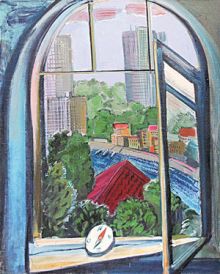Today more and more artists work with the urban motives and urban landscape. However, their vision of the same streets, gardens, and squares is quite different. Ukrainian artist and art expert Vira Vaysberg, currently lives and works in Germany, together with artist and art historian Hlib Vysheslavsky have long been interested in non-tourist view of metropolises. Big cities like Kyiv, Venice, Paris, Barcelona, and Hamburg are depicted on their canvases without tourist exotic, iconic sites, and open angles. Artists paint a city the way its residents see it. Paintings on the display are different stylistically but they stand on one ideological level.
“I TRY TO DEPICT A CITY THAT CONTINUES THE TRADITION OF MAGDEBURG RIGHTS”
“Ukrainian artists of the 19th century worked mostly with natural scenery. Most of the paintings from that period depict open spaces of steppes, forests, and mountains,” said Hlib VYSHESLAVSKY. “As if contrary to this futurists began turning to industrial theme. It was a real challenge for the traditional art, which, however, did not last long because the Soviet authorities practically put an end to the Urban theme and began actively imposing social landscape and convincing everyone that Ukrainian culture is an exclusively rural phenomenon. It was then that Ukrainian cities began to slowly lose their medieval traditions and historical heritage. I am trying to depict a city that continues these traditions and is guided by freedom of Magdeburg Rights.”
The artist paints only those places where he spends a lot of time. When he comes to a new place he asks local residents to show him things that are not usually shown to tourists. He is equally interested in both historically significant places and small quiet lanes. In his opinion, this is the way to see a city from the inside in as a whole without modern “chanson” and all those “bells and whistles” and later to be able to transfer this vision on a canvas.
In paintings created by Vira Vaysberg city is a living body, breathing structure. The artist depicts the general algorithms of Hamburg, which can be felt in any part of the city. North German style of painting allowed her to show the tempo in which the city lives, its main colors, moods, and reliefs. “City” is the Vaysberg’s second exhibition in Ukraine (the first exhibition called “The Jewish Quarter” took place in Kyiv Shalom Aleichem Museum).
Overall, one can see difference between Ukrainian and European cities in the paintings of the two artists. Today residents of Ukrainian metropolises do not feel free and most of these cities remind of big stations from which people always want to go somewhere. According to Vysheslavsky, the Soviets destroyed the sense of historical character in Ukrainian cities, since that time they increasingly lose their completeness.
In important historical centers like Paris or Venice each forcible destruction of the city’s outer look urged its citizens to preserve general historical character of the place. Today in those places it is even forbidden to change the color of fences or shape of fronts in order not to lose the general atmosphere of past centuries. Ukrainian cities will at some point understand the importance of historical awareness. Will anything still be left until then?










